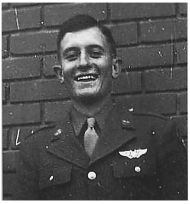

OPPOSITE: Wartime photo of Louis Meehl
After the war started, my brother, Paul, was drafted into the Army Air Corps and was with the Eighth Army Air Force in England. As the sole remaining son in our family, I had a deferment because we had a dairy and were considered essential to war production, and I guess my dad figured I was essential to the dairy. But the longer I stayed at home, and the more my friends were leaving to go into the service, the lonelier it got. I got to looking around, and pretty soon all that was left were the 4-Fs and the draft-dodgers. People would look at me and wonder what was wrong with me and why I was still at home. I finally decided I had to get into the service, and this didn’t make my folks very happy, especially my dad, but I just had to go. So I enlisted in the Army Air Corps. They made me a gunner and sent me to the Pacific. I flew on A-20s in the 417th Bomb Group, B-24s in the 90th, and B-25s in the 38th. I was on islands all through the western Pacific, New Guinea, the Philippines, the Ryukyus, and even up to Japan later on.
It was after the war had ended, and we’d moved up to an airstrip on a little island called Ie Shima, right next to Okinawa. It was the island where Ernie Pyle was killed. We were living there in the usual primitive conditions that we’d put up with on all the islands we’d been based on— tents, C and K rations, nothing to do but fly missions. The airstrip there was right near the beach; well, the island was so small that everything was near the beach, and our tents of course were close to the coast.
We got word a storm was coming, and the pilots flew our squadron’s planes off somewhere. The rest of us on the flight crews and the ground crews were left behind to fend for ourselves. The wind started blowing, the rain was coming down, and we were trying to hold on to our tents to keep them from blowing over. Well, it turned out this storm was a typhoon, what we call a hurricane in the States, and the wind blew stronger and stronger, and the rain was being driven horizontally. What a storm! I’d never experienced anything like it. After a while, we couldn’t hold the tents up anymore. First one of the tents blew down, then another, and pretty soon all the tents were down, and we were outside in the weather. There was no other shelter—our bombing and the Navy’s shelling when we’d taken the island had flattened all the trees, and it was just bare sand and rock. And the wind just kept blowing harder!
Next thing we knew the tents and everything inside them started to blow away, right off the island and out into the ocean. We just couldn’t hold on to them under those conditions—the wind just ripped anything out of your hands if you tried to hold on to it. So after the tents and everything were gone, all we could do was huddle together and try to protect ourselves. It was like we were just a bunch of wet, cold sheep huddled together, and the wind kept blowing even harder. We’d rotate the guys on the outside of our huddle toward the middle because the rain was being blown so hard it hurt when it hit you. We all took our turns on the outside of the group being stung by that wind-driven rain. Some of us had bruises from that rain afterwards.
This seemed to go on for hours, and the whole time we just stayed there huddled together. When the wind and rain finally started to let up, it dawned on us that everything we had was gone. I had a lot of photos from all the islands we’d been on, some souvenirs, and of course the rest of my clothes and personal effects, and they were just gone. Our planes came back, and they flew in some more tents for us, but later when I shipped back to the States I didn’t have much more to take home with me than the clothes I had on the day the storm started!